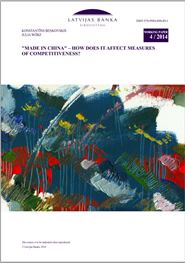"Made in China" – How Does It Affect Measures of Competitiveness?
 4/2014
4/2014
Abstract: We propose a comprehensive analysis of a country's price and non-price competitiveness that accounts for changes in the value added content of trade by combining two datasets – highly disaggregated trade data from UN Comtrade and internationally integrated supply and use tables from the WIOD. When we focus attention on the traditional measure of gross exports of goods, the analysis shows that advanced economies lost non-price competitiveness relative to emerging economies over the period from 1995 to 2011. This picture changes when the fragmentation of production is considered. We find that the relative quality of production from the US, Canada, Germany and the UK, when tracing value added in exports, remained unchanged or even increased over this period. Likewise, the seemingly unchanged or improving relative quality of Brazil, Russia and India's export goods largely arose from outsourcing rather than from improvements in the quality of domestic production. However, gains in Chinese non-price competitiveness remain impressive even after accounting for global value chain integration.
Keywords: value added content of trade, fragmentation, non-price competitiveness, China, BRIC, G7
JEL codes: C43, F12, F15, L15, O47
Textual error
«… …»


